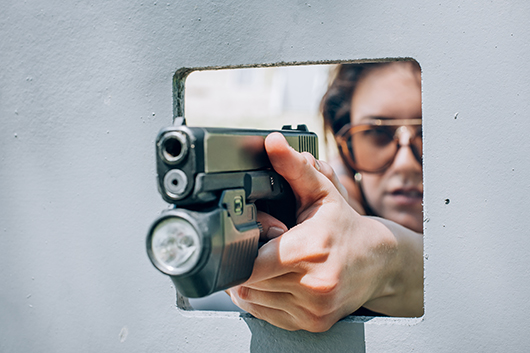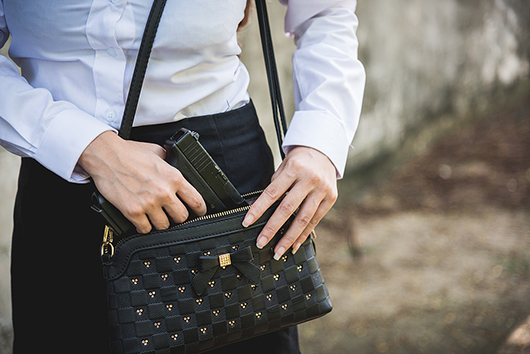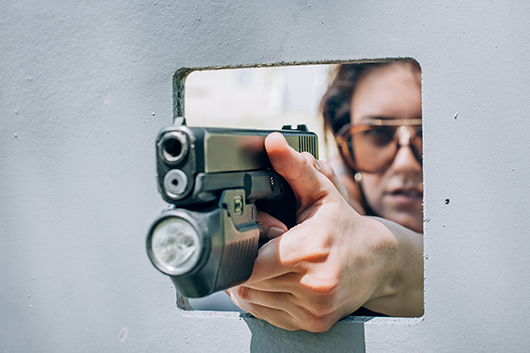Essential Attributes of Gun Holsters for Women
Jan 8th 2021

According to the Crime Prevention Research Center, in those states that report concealed carry permit data by gender, women comprise 36% of CCW permit holders. In 8 states that provide gender-based data, the study continues, the rate of new permit holders increased faster among women. Pew Research also reports that women are more likely than men to cite personal protection as the only reason they choose to own a gun.
Numbers aside, what’s clear is that women choose to carry firearms daily for the same reasons men do — to protect themselves against potentially lethal violence or the threat thereof.
The primary differences between men and women regarding holsters are the manner of dress and physical shape. However, the underlying principles remain the same.
Dresses, skirts, and other traditionally feminine clothing, which cover a woman’s holster may pose unique challenges for ensuring that a concealed firearm remains both safe and secure. These challenges are by no means insurmountable, however.
Fortunately, there are various methods of carrying a firearm, carrying positions, and other universal and gender-specific considerations to help women.
On- or Off-Body Carry?

If you’re able-bodied, off-body concealed carry options, such as a purse or handbag, should generally be avoided. Having to open a zipper or snap closure to retrieve your weapon reduces accessibility.
Should you experience an assault or attempted robbery, a purse is something a mugger targets immediately. You don’t want to risk losing both your valuables and your means of personal protection. Keeping your carry gun on your person is best.
However, some circumstances don’t permit you to carry on your person. If you’re pregnant or physically disabled, your situation may require alternative arrangements, in which case an off-body carry method, such as a dedicated gun purse, may be the best option.
Essential Attributes of a Gun Holster
First, it’s worth listing those elements that every gun holster should incorporate, regardless of whether the manufacturer intended a man or a woman to wear it. These are:
- Safety: Ideally, a gun holster should cover the trigger guard. When you reach for your firearm, you should be confident that proper observance of firearms safety rules should be sufficient to ensure a safe draw stroke. No matter how much you practice, if the holster design forces your index finger to enter the trigger guard, or doesn’t adequately protect it, your risk of an accident increases.
- Security: Related to safety in a sense, retention systems, whether active or passive, that keep your firearm from being drawn by an unauthorized person are essential. These range from simple snap-closure thumb breaks to sophisticated locking systems with buttons that you depress as you draw. Kydex holsters often rely on friction between the holster material and the firearm to keep the weapon secure. This is adjustable using tension screws or other mechanisms.
- Accessibility: Once the holster design’s safety and security have been established, accessibility should be your priority. You’re carrying a firearm to defend your life or the lives of those for whom you care, so your carry weapon should be readily accessible when you need it to be.
However, accessibility is not strictly a holster function but depends on where you place the holster and how you dress. If you carry under a dress or a skirt, for example, you’ll need to find the best way to sweep or raise the fabric out of the way.
- Concealability: This isn’t essential to gun carrying in general, but regarding concealed carry, discretion is vital. How well your holster covers your firearm will also depend on other factors, such as your choice of firearm and clothing. However, some holsters are designed to print less through a cover garment and conform more effectively to the body’s natural curves.
Concealed Carry Positions
When deciding to carry a firearm, you’ll have to determine, first, where you want to carry it on your body. This will depend on several factors, such as your body type. You should also be aware of two abbreviations: IWB (in the waistband) and OWB (outside the waistband).
An IWB holster lets you carry a firearm between the waistband and the body. This method increases the concealment, as the holster and the gun are partially hidden by your pants, but can be uncomfortable for larger weapons and may require a change of clothing size. OWB is the opposite: by placing the weapon outside the pants, it offers less concealment but more comfortable carry, especially with full-size handguns.
When discussing CCW holster’s placement, it’s common to see references to the times on a 12-hour clock face. Some common positions include:
- Strongside: Your strong side corresponds to your dominant hand. If you’re right-handed, your strong side is at 3 o’clock — your right hip. If you’re left-handed, this is at 9 o’clock.
- Crossdraw: In a cross-draw setup, the handgun is carried butt forward on the support side, opposite the dominant hand.
- Appendix: Located at approximately 12 or 1 o’clock, this places the handgun directly in front of you for rapid access.
- Small of back: This is at 6 o’clock, and positions the handgun against the arch of your back, keeping it away from the cover garment.
Body Types
Yes, your body type does play a role but don’t be alarmed. This doesn’t necessarily mean that you can’t carry your firearm in the way you want. It simply means that you will have to experiment to find the most comfortable and accessible concealed carry method and position.
If you’re pregnant or have a pronounced beltline, appendix carry may prove difficult for you. However, the only way you’ll be able to determine that is through trial and error.
Types of Concealed Carry Holster
Besides methods of carrying and carry positions, there are many types of concealment holsters to choose from. These include:
- Ankle holster: This type of holster is suitable for backup or subcompact firearms. However, it falls short to carry your primary weapon because it’s awkward to access under time pressure, requires that you change your stance, and limits the size of the guns you can carry.
- Belly band holster: A wide elastic band that wraps around the waist and closes with Velcro, the belly band holster doesn’t rely on a traditional belt to secure your firearm. This opens your wardrobe options and doesn’t limit you to any particular type of attire. If you prefer to wear dresses or sportswear, this may be an option to consider.
- Corset holster: Similar in principle to the belly band, the corset wraps around the waist but relies on zippers or brassiere-like clasps for closure in the front. The corset design usually includes two compartments — one for the handgun and another for spare magazines.
- Thigh holster: No, not the tactical thigh holster you see law enforcement officers wear. The kind discussed here is more of an elastic band that holds the pistol snugly against your leg. This type can be useful when wearing a dress, skirt, or another free-flowing garment.
- Shoulder holster: Not only a relic of action films and detective dramas, if you’d prefer to carry your handgun under a jacket or business suit, but this can also be a comfortable alternative to carrying on your belt or wrapped around your waist. This type is advantageous for larger handguns, but is more suitable for colder climates.
In Conclusion
Women are increasingly choosing to exercise their Second Amendment rights by carrying firearms openly and concealed for self-defense. At Incognito Concealment, we support teaching women concealed-carry fundamentals, such as proper holster use and firearms handling. Self-defense is a human right that everyone responsible and willing should learn.
If you’re new to firearms or concealed carry and would like to discuss holster types and concealed carry methods, we’d be happy to answer any questions that you may have. Call us at (586) 333-4240 — we have a full complement of Kydex holsters that should serve your needs.











